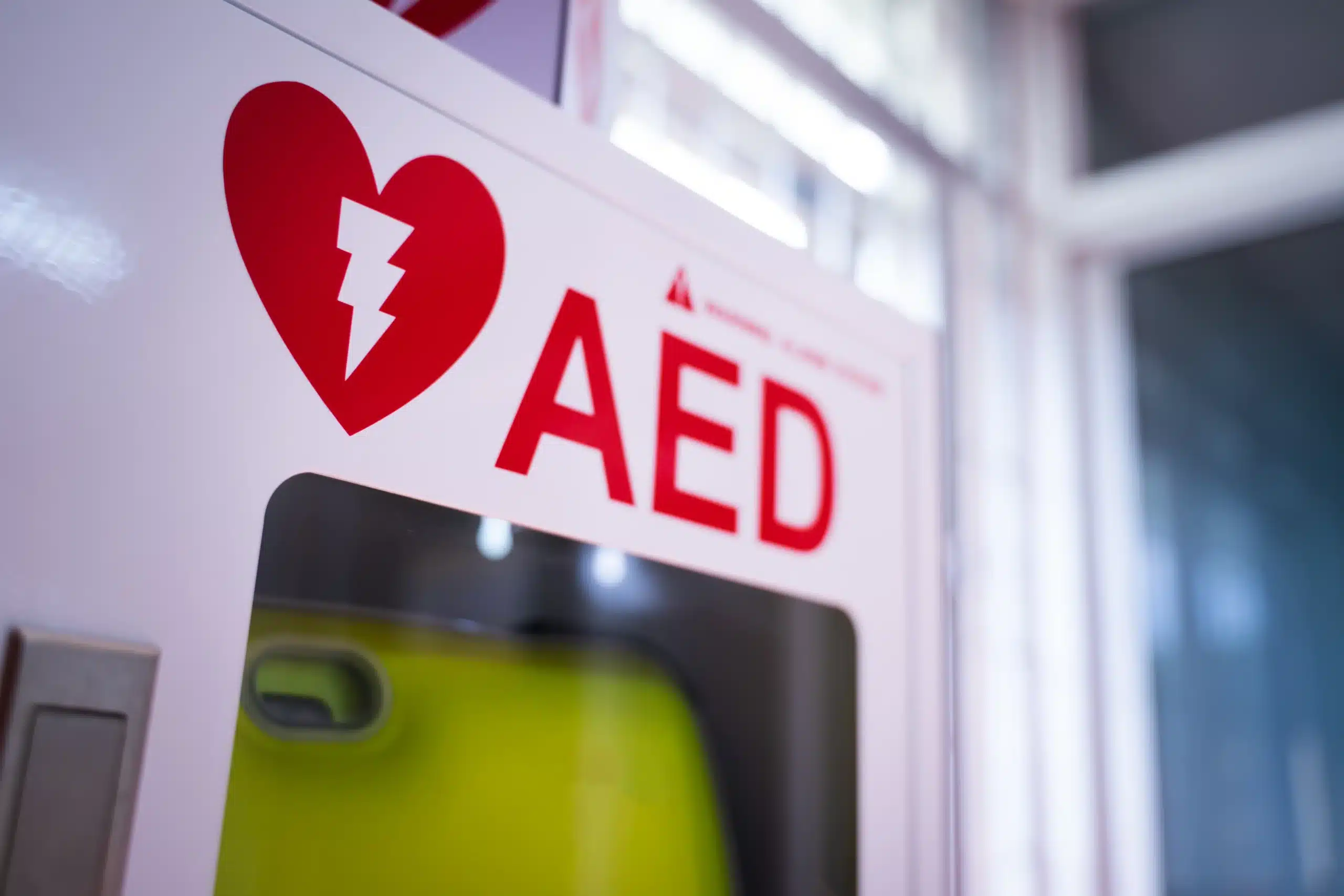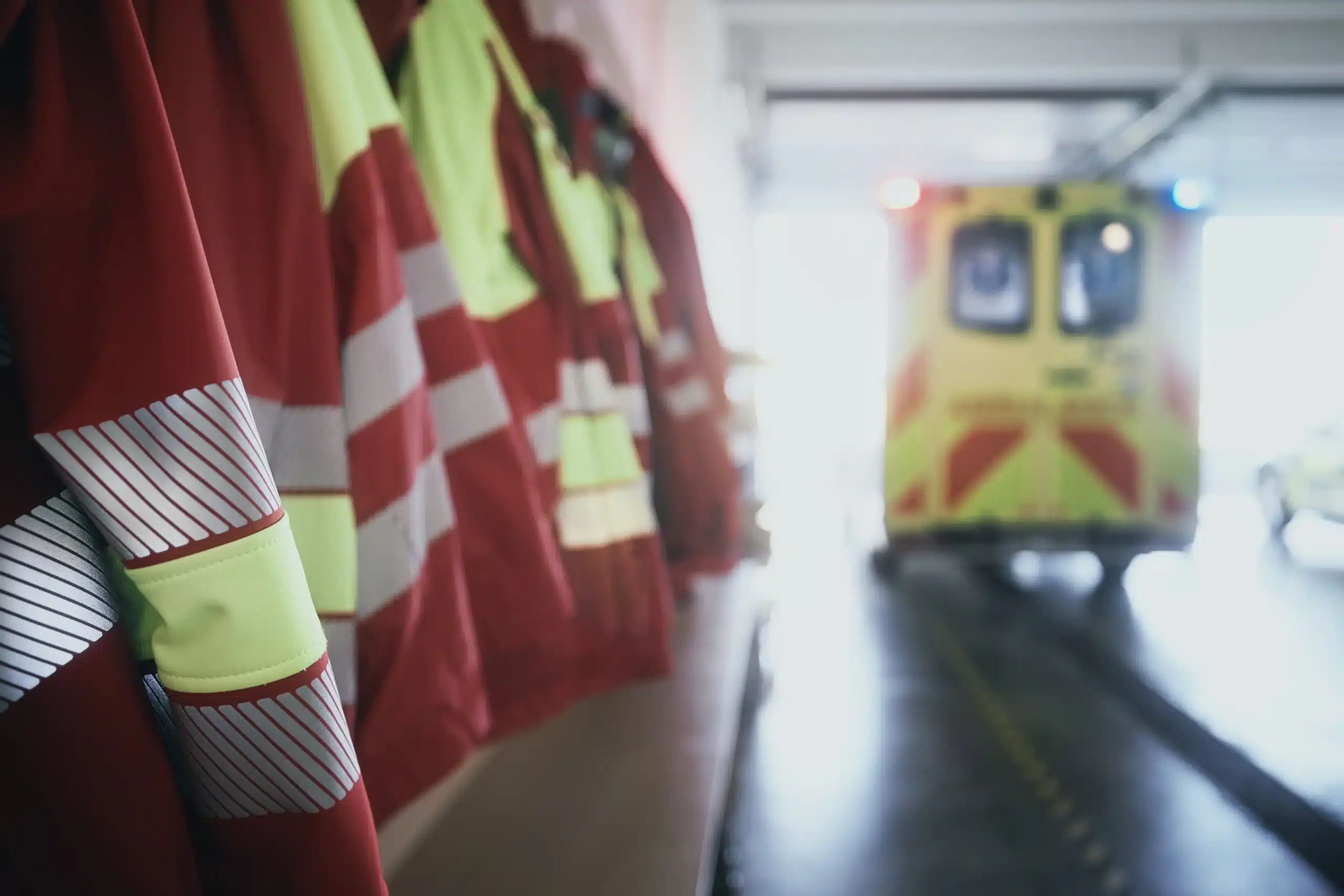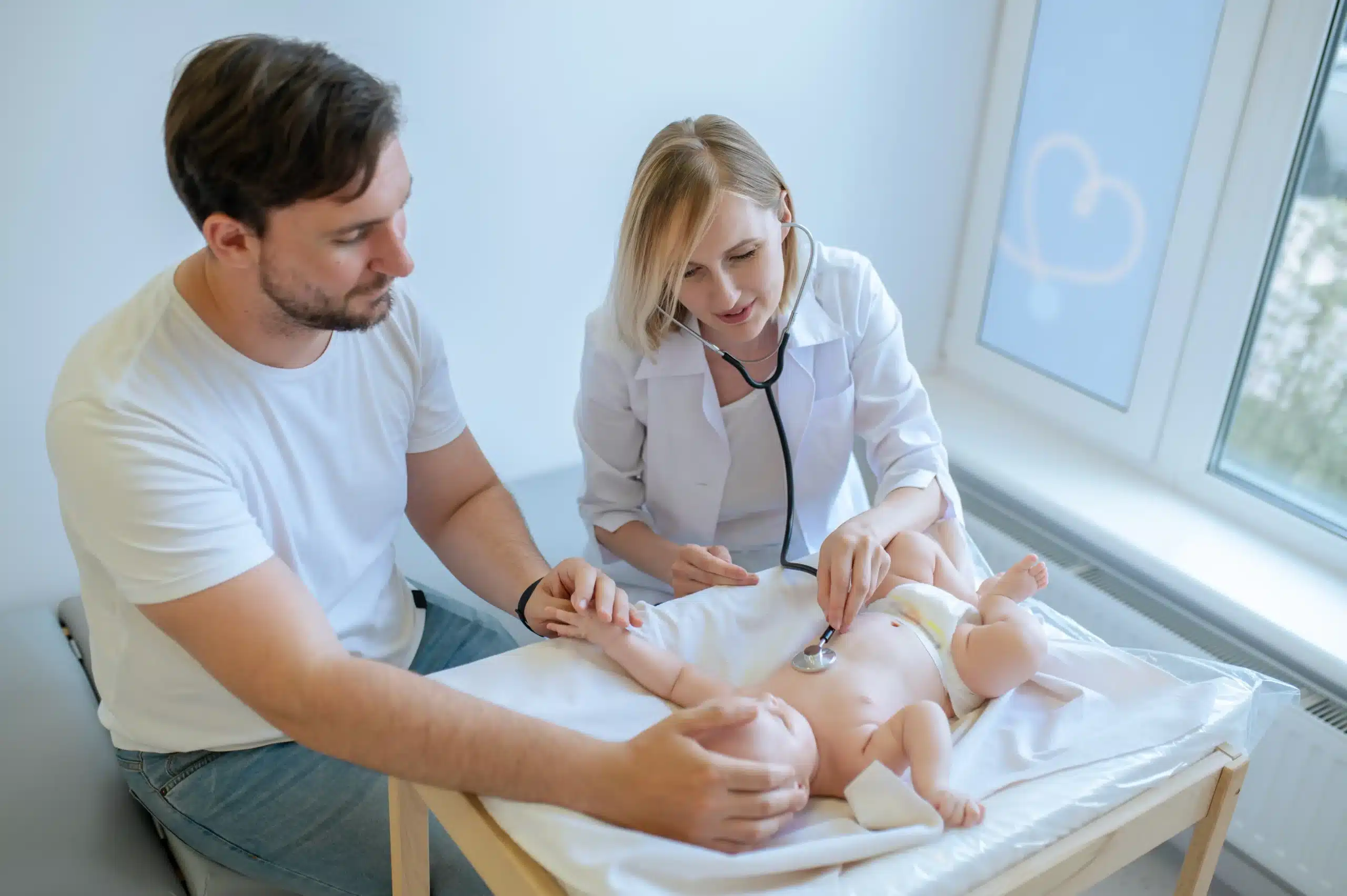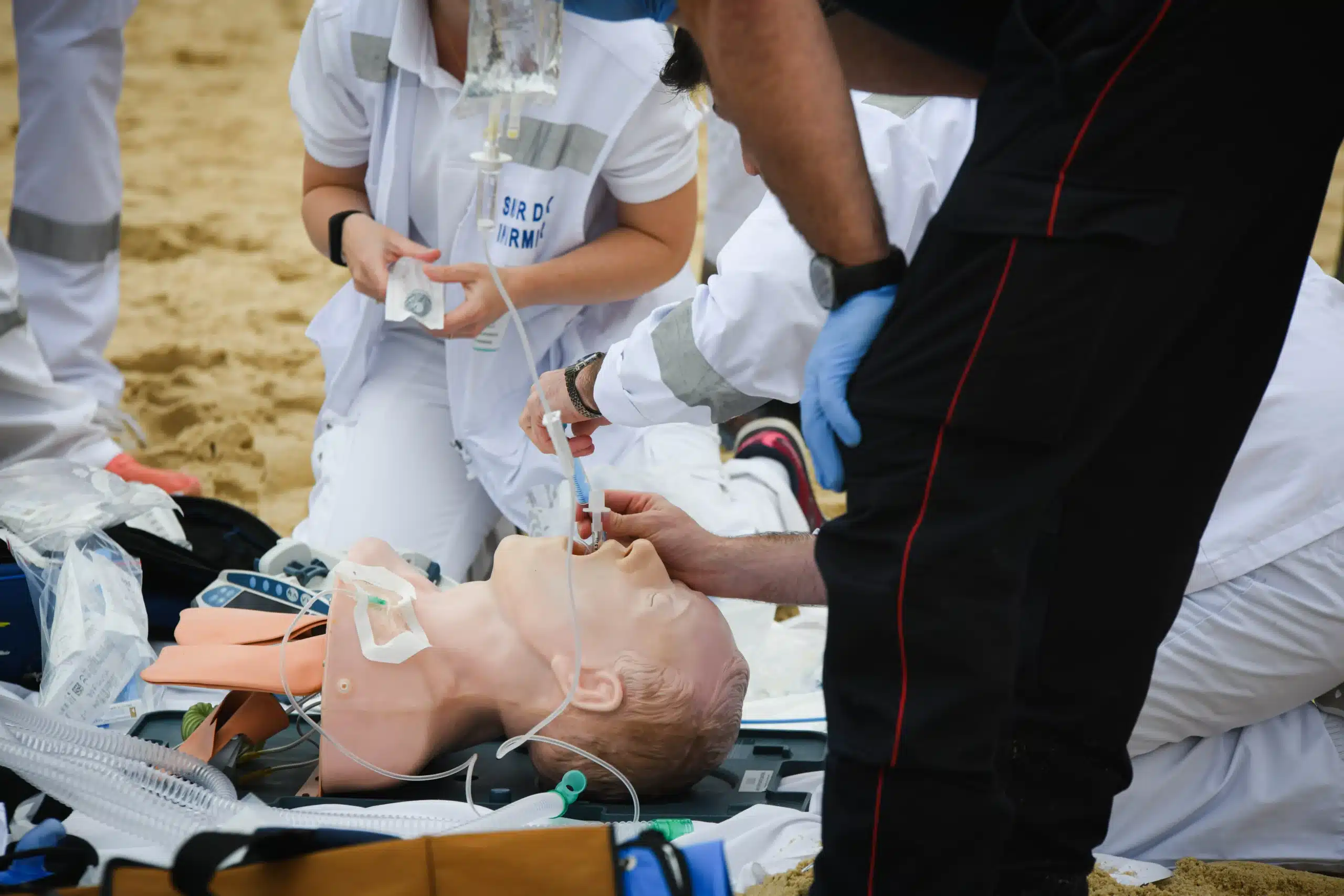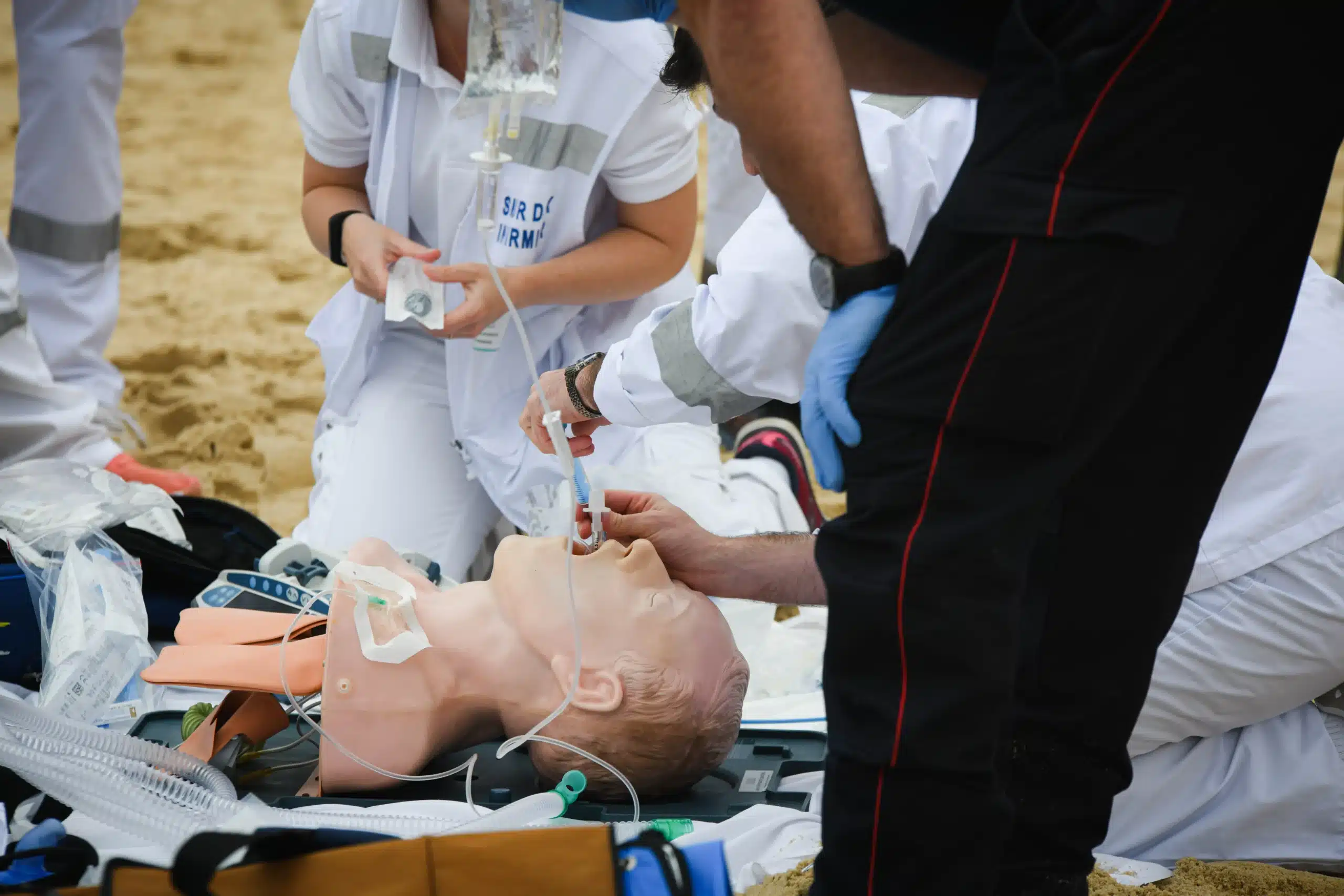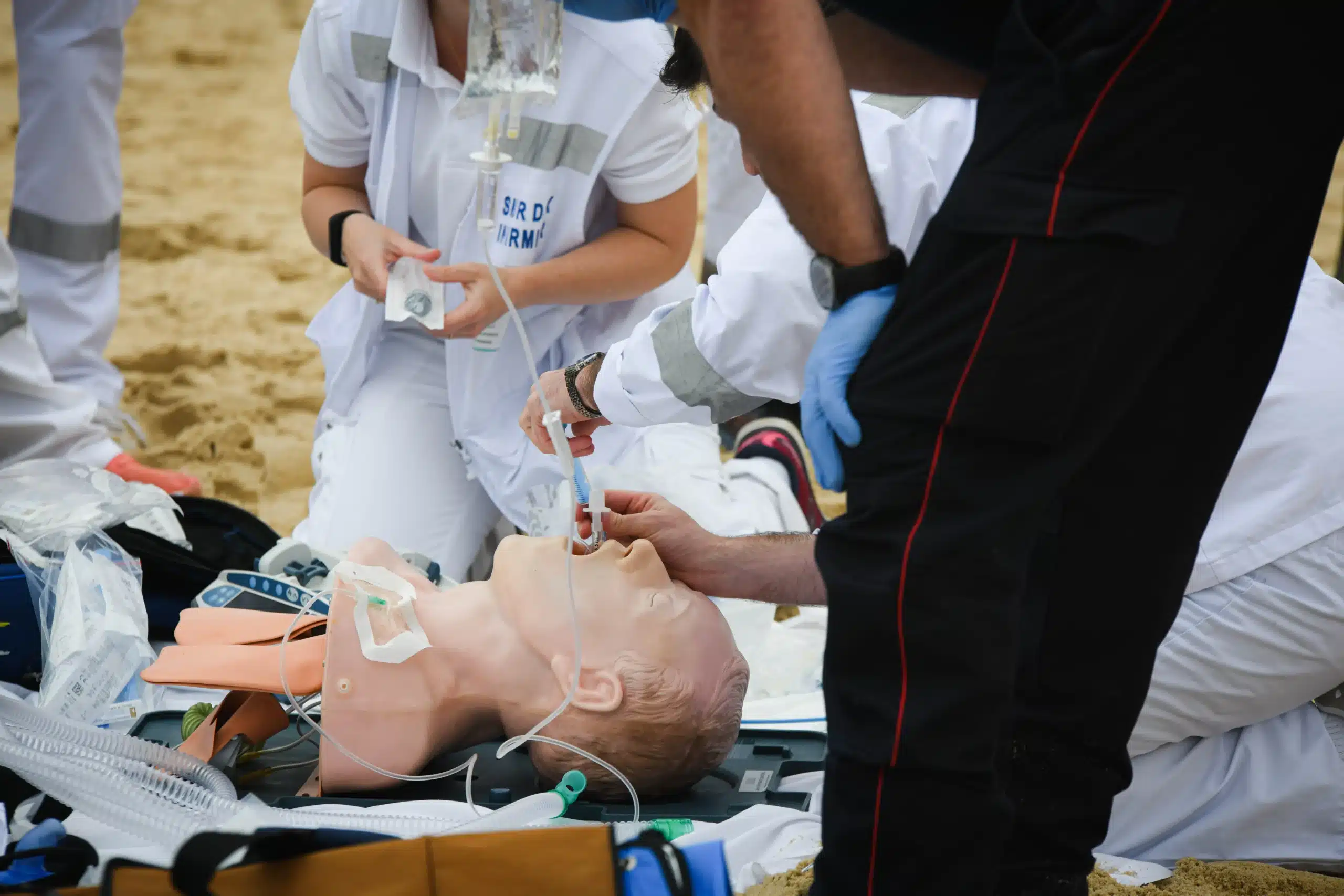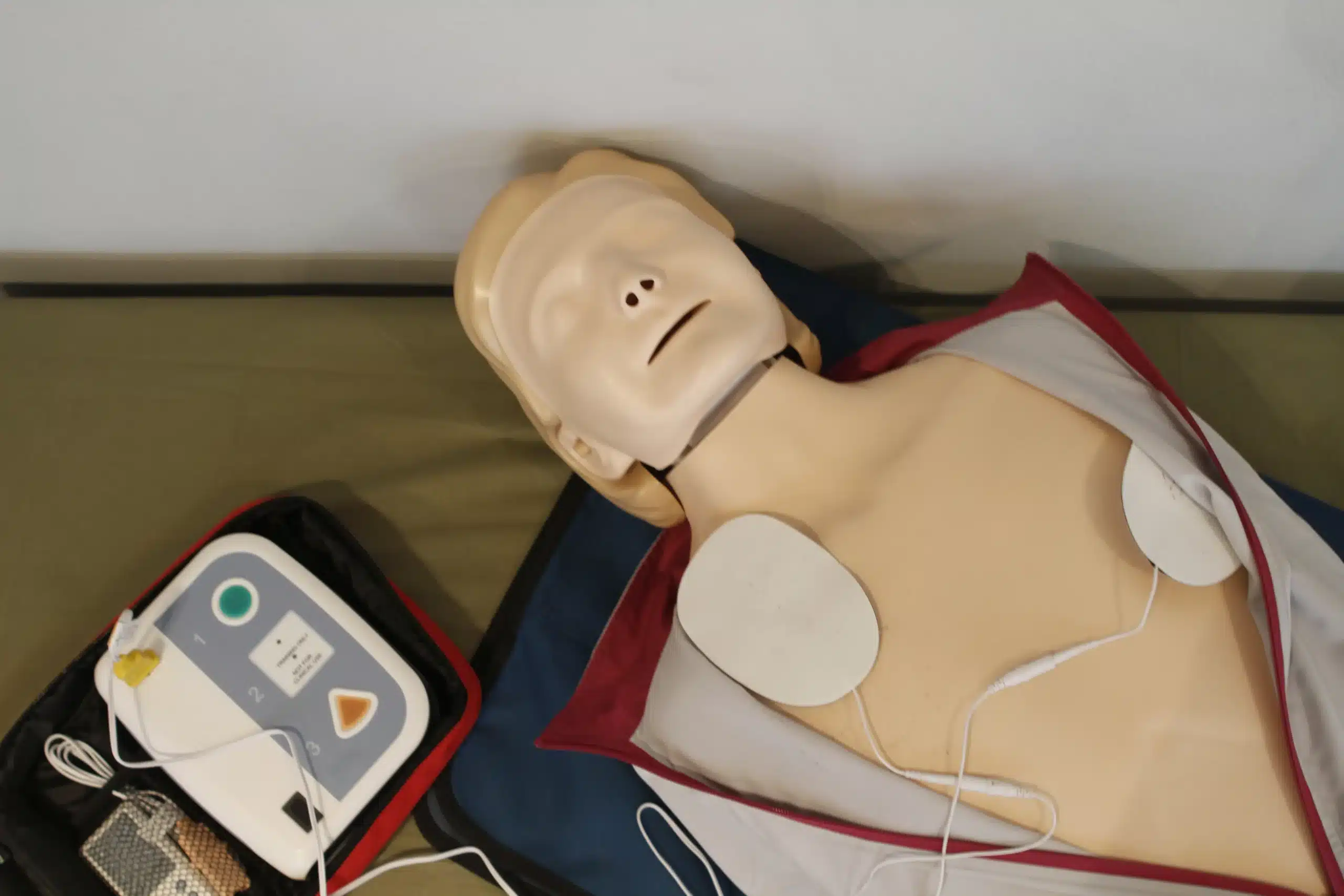Emergencies happen, and when they do, being prepared can change the outcome. First-aid training equips you with the skills to respond quickly and confidently in critical situations. This guide is your go-to resource for understanding the importance of first aid, the different types of training available, and how to find “first-aid classes near me.” We’ll explore the benefits of first-aid certification, whether you’re a parent, a teacher, a healthcare professional, or simply someone who wants to be prepared for anything. Let’s dive in and empower you to make a difference.
Key Takeaways
- First aid is practical knowledge: Equipping yourself with first-aid skills enables you to confidently handle common injuries and provide immediate assistance in various emergencies.
- Choose the right training: Explore different first-aid and CPR/AED courses to find one that suits your individual needs, whether you’re a parent, healthcare provider, or outdoor enthusiast.
- Stay prepared: Maintain your first-aid skills through regular practice and renewal courses, ensuring you can always respond effectively and potentially save a life.
What Are First-Aid Classes?
First-aid classes teach you how to handle emergencies. These courses blend lessons with hands-on practice, giving you the skills and confidence to act quickly when it matters most. You’ll learn to assess injuries, control bleeding, manage fractures, and care for someone who’s choking. It’s about equipping yourself to potentially save a life. First-aid training is crucial for being prepared for emergencies, providing you with the skills to offer immediate assistance.
First-aid training covers a wide range of situations, from everyday mishaps like cuts and burns to more serious events. Think of it as a practical toolkit for responding to injuries and illnesses before professional help arrives. Whether you’re a parent, teacher, coach, or just someone who wants to be prepared, first-aid training can make a real difference. Our CPR and first-aid certification courses at Safety Training Seminars are designed to empower you to handle emergencies effectively.
Types of First-Aid Classes
Whether you’re a concerned parent, a healthcare provider, or simply someone who wants to be prepared for emergencies, understanding the different types of first-aid classes can help you choose the right training. Let’s take a look at the most common options:
Basic First Aid
Basic first-aid classes give you foundational knowledge and practical skills to handle common injuries and medical emergencies. These courses typically cover treating minor wounds, burns, sprains, and recognizing the signs of serious medical conditions like heart attacks or strokes. You’ll learn essential techniques like how to control bleeding, manage shock, and when to call 911. Basic first aid is an excellent starting point for anyone looking to develop practical skills they can use in everyday situations.
CPR and AED Training
CPR (Cardiopulmonary Resuscitation) and AED (Automated External Defibrillator) training are invaluable, potentially life-saving skills. CPR teaches you how to restore blood circulation and breathing in someone who has experienced cardiac arrest. AED training shows you how to use an automated external defibrillator, a device that can help restore a normal heart rhythm. These courses often combine CPR and AED instruction, offering well-rounded training for responding to cardiac emergencies. Many workplaces and community organizations require CPR/AED certification—it’s a smart move to have this training under your belt. Pleasanton CPR Classes offers various CPR and first-aid certification courses.
Specialized First-Aid Courses
Beyond the basics of first aid and CPR/AED training, you can find specialized courses designed for specific needs and professions. These might include pediatric first aid for childcare providers, wilderness first aid for outdoor adventurers, or occupational first aid for workplace safety. Some specialized courses offer more in-depth training on specific medical conditions or injuries, providing advanced skills and knowledge. If you work in a particular field or have specific interests, exploring specialized first-aid training can boost your preparedness and give you specialized expertise. For instance, you can find more information on CPR classes, including those for businesses and groups, at CPR Education.
Find Reputable First-Aid Classes Near You
Finding the right first-aid class involves a bit of research to ensure you’re getting quality instruction. Here’s a straightforward approach:
Search Online
Start by searching online. Use search engines like Google or DuckDuckGo, or online maps, to find local providers. Search for terms like “first aid classes near me,” “CPR and first aid certification,” or “first aid training [your city/region].” Look for providers with websites that clearly outline their courses, schedules, and instructor qualifications. Pleasanton CPR Classes, for example, offers a range of certification courses with all the details readily available online.
Evaluate Training Providers
Choosing the right training provider is key to receiving accurate and effective instruction. Look for established providers with a solid reputation. Check online reviews and testimonials to see what past students say. The provider’s website should clearly list certifications, accreditations, and instructor qualifications. Don’t hesitate to contact providers directly with any questions about their programs. Ask about the instructor’s experience and whether the curriculum aligns with recognized guidelines, such as those from the American Heart Association. Consider factors like class size, as this can affect how much individual attention you receive. Smaller classes often allow for more personalized instruction.
Check Certifications and Accreditations
Ensure the training provider and instructors have valid certifications and accreditations from recognized organizations. This confirms they meet established standards for first-aid training. Reputable organizations, like the American Heart Association and the American Red Cross, offer accreditation programs. Check if the provider is affiliated with these organizations or other nationally recognized bodies. A provider’s accreditation shows their commitment to quality and adherence to industry best practices. This is a crucial step in verifying the legitimacy and quality of the training.
How Much Do First-Aid Classes Cost?
Knowing the cost of first-aid training is an important part of planning your certification. While prices vary, understanding the factors involved helps you budget and find the best value. Let’s break down average costs, potential discounts, and what to watch out for.
Average Prices
First-aid class costs depend on several factors, including the level of training, course format (online or in-person), and your location. Basic first-aid and CPR certification often falls between $75 and $150. More specialized courses, such as wilderness first aid or advanced life support, typically have higher prices due to the increased instruction and materials required. Pleasanton CPR Classes offers a range of courses and a low price guarantee to fit your needs and budget. You can find CPR and first-aid training suitable for healthcare providers, workplace requirements, or personal knowledge.
Group Discounts and Special Offers
Many training centers offer discounts for group bookings, making it a cost-effective option for workplaces, community groups, or families learning together. Pleasanton CPR Classes provides group discounts, so ask about special rates if you’re registering with multiple people. Also, keep an eye out for seasonal promotions or discounts for students, seniors, or other groups.
Hidden Costs
Beyond the initial course fee, consider additional expenses like study materials, certification card fees, or travel costs to the training location. Some providers include these in the advertised price, while others may list them separately. Clarify exactly what’s covered when comparing prices. Pleasanton CPR Classes offers various courses, including BLS CPR for healthcare professionals, and can help you understand any associated costs upfront. Choosing a training center with transparent pricing helps you avoid unexpected expenses and budget effectively.
CPR vs. First Aid: Which Training Do You Need?
Deciding between CPR and First Aid training, or whether you need both, depends on your goals and circumstances. This section clarifies the differences and helps you make the right choice.
Understand the Differences
CPR (Cardiopulmonary Resuscitation) focuses on helping someone whose heart has stopped. It involves chest compressions and rescue breaths to keep oxygenated blood flowing to the brain and vital organs. CPR itself doesn’t restart the heart; it buys crucial time until professional help arrives and a defibrillator can be used or advanced life support can begin. For more information on CPR techniques, see our BLS (Basic Life Support) page.
First Aid addresses a broader range of emergencies, including treating injuries like cuts, burns, sprains, fractures, and choking. It teaches practical techniques like applying pressure to stop bleeding, dressing wounds, and immobilizing injured limbs. Our CPR and First Aid certification courses cover these essential skills.
Choose the Right Course
The right course depends on your individual needs. Are you a healthcare professional, a childcare provider, or someone who wants to be prepared for everyday emergencies? Pleasanton CPR Classes offers various levels of certification, from basic CPR and first aid to advanced life support (ACLS and PALS), so you can find the perfect fit. We also offer RQI classes for healthcare providers needing to renew their resuscitation certifications. For cost-effective options, check out our group discounts.
Combine CPR and First Aid Training
While each training has a different focus, taking both CPR and First Aid classes together is highly recommended. This prepares you to handle a wider variety of emergencies, from sudden cardiac arrest to a minor injury. Being trained in both significantly increases your ability to help in critical situations. Pleasanton CPR Classes offers combined CPR & First-Aid certification classes. We’re committed to providing high-quality, affordable training, backed by our low price guarantee.
What to Expect in a First-Aid Class
So, you’ve decided to learn first aid—fantastic! Now, you’re probably wondering what the experience will actually be like. Let’s break down what you can expect in a typical first-aid class.
Course Duration and Format
First-aid classes blend theoretical learning with hands-on practice. You’ll learn the essentials through interactive discussions, presentations, and real-life scenarios. Expect a mix of learning styles to keep things engaging. Pleasanton CPR Classes offers various levels of certification, from basic first aid to more advanced courses, so you can find the right fit for your needs.
Practice and Assessments
The best way to solidify your first-aid knowledge is to put it into action. A good first-aid course will incorporate plenty of hands-on practice sessions. You’ll work with training equipment and realistic simulations to build your confidence and competence in applying essential techniques. Look for a training provider with certified instructors and real-world experience. This practical experience is key to feeling prepared for real-life emergencies. You’ll likely have some form of assessment to ensure you’ve grasped the key concepts and skills. This might involve demonstrating specific techniques or a written exam.
Get Certified
Upon successful completion of your first-aid class, you’ll receive an official certification card. This card validates your training and shows your ability to provide basic medical assistance in emergencies. Make sure your chosen provider offers certifications recognized by established organizations like the American Heart Association or the American Red Cross. This ensures your certification is widely accepted. With your first-aid certification, you’ll be well-equipped to make a real difference.
Benefits of First-Aid Training
Knowing what to do in a medical emergency can make all the difference. First-aid training equips you with the skills and confidence to respond effectively, whether at home, in the workplace, or out in your community. It’s about more than just bandages and CPR—it’s about empowering yourself to potentially save a life.
Personal Preparedness
Life is unpredictable. Accidents can happen anytime, anywhere. Having first-aid training means you’re prepared. Instead of feeling helpless during a medical emergency, you’ll be able to assess the situation, provide immediate care, and potentially prevent a situation from worsening. Choosing the right first-aid training provider is crucial for learning accurate and effective techniques. Pleasanton CPR Classes offers a blend of classroom instruction and hands-on training to prepare you for real-life scenarios.
Workplace Safety
First-aid training is a valuable asset in any workplace. From minor cuts and burns to more serious incidents, having trained first-aiders on-site can significantly reduce the severity of injuries. For those in the medical field, BLS certification is often a job requirement. Equipping your team with first-aid skills creates a safer work environment and demonstrates a commitment to employee well-being. Comprehensive first-aid training provides individuals with the skills to respond effectively to various emergencies, potentially saving lives.
Community Impact
First-aid training empowers individuals to make a real difference in their communities. By learning these essential skills, you become a valuable resource for your neighbors, friends, and family. Whether it’s assisting at a local event, responding to an accident, or simply being prepared for everyday mishaps, your training can have a ripple effect, creating a safer and more resilient community. CPR and First Aid certification plays a vital role in community safety, and local organizations like Safety Training Seminars provide these essential courses.
Top First-Aid Training Providers
Finding the right first-aid training provider is crucial for a high-quality learning experience and a recognized certification. Here are a few reputable organizations and companies that offer first-aid training:
Safety Training Seminars
If you’re near Pleasanton, Dublin, or San Ramon, California, Safety Training Seminars offers a convenient option for your first-aid training needs. As a woman-owned American Heart Association (AHA) Training Center, they offer various courses, including CPR, BLS, ACLS, PALS, and First Aid. Located at 4725 First Street, Suite 225, in Pleasanton, they provide classes daily to fit your schedule. Visit their website for more details.
American Red Cross
The American Red Cross is a trusted organization with a rich history of providing first-aid training. They offer a range of courses suitable for the workplace and individuals, known for their comprehensive approach. Explore their first-aid training options online.
American Heart Association
The American Heart Association (AHA) is a leading provider of CPR and first-aid training. Their courses adhere to industry standards and benefit both healthcare providers and the general public. AHA courses equip you with essential life-saving skills.
National Safety Council
The National Safety Council offers a wide array of first-aid training programs. These programs cater to diverse needs and ensure you gain the skills to handle emergencies effectively. Learn more about their training programs on their site.
St. John Ambulance
St. John Ambulance is a respected international organization recognized for its high-quality first-aid training. Their courses are acknowledged globally and provide practical skills and knowledge to manage various emergencies. Explore their course offerings to find the right fit.
ProTrainings
ProTrainings offers the flexibility of online and in-person first-aid training courses. These courses accommodate different learning preferences and cover essential life-saving techniques. Visit their website for more information.
Prepare for Your First-Aid Class
So, you’ve signed up for a first-aid class—congratulations! Taking a first-aid course is a rewarding experience. To make the most of your upcoming training, here’s how to prepare.
What to Bring
First-aid classes are typically hands-on, so comfortable clothing is essential. You’ll want to move freely during practice scenarios. Bring a notebook and pen to jot down key takeaways and any questions for your instructor. They will provide any necessary equipment, like bandages and CPR mannequins. Check with Pleasanton CPR Classes to see if they recommend bringing anything specific.
Pre-Course Study Materials
Pleasanton CPR Classes may offer pre-course materials. Check their website or contact them directly to see what’s available. Reviewing this information can give you a head start and boost your confidence before class. If your chosen provider doesn’t offer materials, don’t worry! The instructor will cover everything you need to know during the course. Looking for a reputable provider? Choose one with accreditation and expertise.
Mental Preparation
It’s normal to feel a little nervous before a new learning experience. Remember, first-aid classes are designed for people of all backgrounds, even those with no prior medical knowledge. The instructors at Pleasanton CPR Classes create a supportive learning environment. The best providers have a solid reputation and positive feedback from past students. Come prepared to participate actively, ask questions, and learn life-saving skills. You’ve got this!
Maintain Your First-Aid Skills
Once you’ve earned your first-aid certification, remember that these skills require upkeep. Regular practice and renewal courses are key to staying prepared for emergencies. Let’s explore how you can maintain your first-aid skills and confidence.
Renewal Requirements
First-aid certifications, like those for CPR, are typically valid for two years. Check with your certifying organization, such as the American Red Cross or the American Heart Association, for specific renewal guidelines. Pleasanton CPR Classes offers a variety of renewal courses to help you easily extend your certification. Even if your certification has lapsed, remember that attempting first aid in an emergency is always better than doing nothing.
Ongoing Practice
The best way to maintain your first-aid skills is to practice them regularly. Consider creating simulated emergency scenarios with friends or family to practice applying bandages, stabilizing injuries, or performing CPR. You can also review your course materials and first-aid manuals periodically to refresh your knowledge. Organizations like the Red Cross offer resources and guidelines to help you stay up-to-date on the latest first-aid practices. Consider refreshing your CPR skills regularly as well; Pleasanton CPR Classes offers RQI classes to help you maintain these life-saving skills.
Refresher Courses
Even if your certification is still valid, taking refresher courses can be incredibly beneficial. These courses reinforce your existing knowledge and introduce you to any updated procedures or guidelines. Pleasanton CPR Classes offers a range of first-aid classes that can serve as excellent refreshers. Combining CPR and first-aid training is also a smart move, preparing you for a wider range of emergencies. Consider taking a CPR and First Aid class to ensure you’re ready for anything. Check out our low price guarantee and our convenient group discounts for added value.
Related Articles
- First Aid Training in Dublin: A Complete Guide – Pleasanton CPR Classes
- First-Aid Training in Pleasanton: Your Certification Guide – Pleasanton CPR Classes
- First Aid Classes in Pleasanton: Your Guide – Pleasanton CPR Classes
- CPR Certification in Dublin: Your Guide – Pleasanton CPR Classes
- Why CPR is Critical in Healthcare and Life-saving Emergencies
Frequently Asked Questions
What’s the difference between CPR and first aid? CPR focuses specifically on reviving someone whose heart has stopped beating. First aid covers a much broader range of medical emergencies, from treating minor cuts and burns to handling more serious injuries like fractures and choking. While distinct, they often complement each other, and many choose to become certified in both.
How do I choose a reputable first-aid training provider? Look for providers with accreditation from recognized organizations like the American Heart Association or the American Red Cross. Check online reviews, ask about instructor qualifications, and confirm what’s included in the course fee. A provider’s website should clearly outline their certifications, course content, and instructor experience. Don’t hesitate to contact them directly with any questions.
How long does a first-aid certification last, and how do I renew it? Most first-aid certifications are valid for about two years. Check with your certifying organization for their specific renewal policy. Many training centers offer renewal courses, often streamlining the process for those who’ve previously certified with them. Staying current with your certification ensures you’re up-to-date on the latest procedures.
What if I’m nervous about taking a first-aid class? It’s perfectly normal to feel a bit apprehensive, especially if you have no prior medical experience. Remember, first-aid classes are designed for people of all backgrounds. Good instructors create a supportive and encouraging learning environment. Focus on active participation, ask questions, and trust the process. You’ll be surprised at how quickly you gain confidence.
How can I keep my first-aid skills sharp after I’m certified? Regular practice is key. Review your course materials periodically, and consider creating mock emergency scenarios with friends or family to practice your skills. Taking refresher courses, even before your certification expires, can also be a great way to reinforce your knowledge and stay up-to-date on any changes in first-aid procedures.
